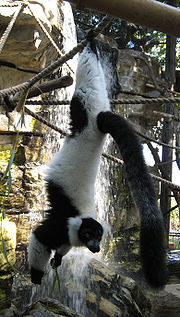
Suspensory behavior
Encyclopedia

Primate
A primate is a mammal of the order Primates , which contains prosimians and simians. Primates arose from ancestors that lived in the trees of tropical forests; many primate characteristics represent adaptations to life in this challenging three-dimensional environment...
s, is a form of arboreal locomotion
Arboreal locomotion
Arboreal locomotion is the locomotion of animals in trees. In every habitat in which trees are present, animals have evolved to move in them. Some animals may only scale trees occasionally, while others are exclusively arboreal. These habitats pose numerous mechanical challenges to animals...
or a feeding behavior which involves hanging or suspension of the body below or among the branches, rather than moving or sitting on top of the branches. This includes brachiation
Brachiation
Brachiation is a form of arboreal locomotion in which primates swing from tree limb to tree limb using only their arms.- Brachiators :...
, climbing
Arboreal locomotion
Arboreal locomotion is the locomotion of animals in trees. In every habitat in which trees are present, animals have evolved to move in them. Some animals may only scale trees occasionally, while others are exclusively arboreal. These habitats pose numerous mechanical challenges to animals...
, and bridging, and allows larger species to distribute their weight among smaller branches rather than balancing above these weak supports. Ruffed lemur
Ruffed lemur
The ruffed lemurs of the genus Varecia are strepsirrhine primates and the largest extant lemurs within the family Lemuridae. Like all living lemurs, they are found only on the island of Madagascar...
s, sifaka
Sifaka
Sifakas are a genus of lemur from the family Indriidae within the order Primates. Their name of the family is an onomatopoeia of their characteristic "shi-fak" alarm call. Like all lemurs, they are found only on the island of Madagascar...
s, spider monkey
Spider monkey
Spider monkeys of the genus Ateles are New World monkeys in the subfamily Atelinae, family Atelidae. Like other atelines, they are found in tropical forests of Central and South America, from southern Mexico to Brazil...
s, gibbon
Gibbon
Gibbons are apes in the family Hylobatidae . The family is divided into four genera based on their diploid chromosome number: Hylobates , Hoolock , Nomascus , and Symphalangus . The extinct Bunopithecus sericus is a gibbon or gibbon-like ape which, until recently, was thought to be closely related...
s, and orangutan
Orangutan
Orangutans are the only exclusively Asian genus of extant great ape. The largest living arboreal animals, they have proportionally longer arms than the other, more terrestrial, great apes. They are among the most intelligent primates and use a variety of sophisticated tools, also making sleeping...
s are examples of primates that exhibit suspensory behaviors.

